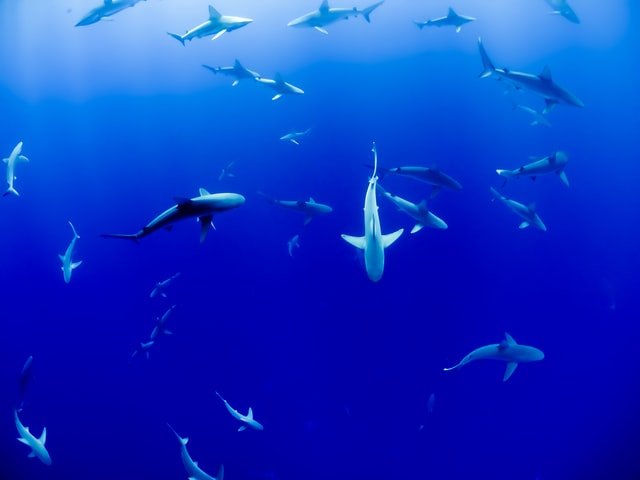In this article, you’ll learn about the forage behaviour of sharks. You’ll find out based on rough estimations, how often sharks forage in their marine environment.
How often do sharks eat?
Different shark species have different feeding frequency. Some sharks eat as often as everyday or every other day while others are able to go a whole week without actively foraging for food.
Different species, different routine
Generally speaking and on a daily basis, virtually all species of sharks are perfectly capable of surviving on a small-scale marine diet representing 0.5 to 3 percent of their total body weight.
This means is that a 100 pounds shark can easily survive on a 3 pounds diet of bony fishes, turtles, small mackerels or whatever meal represents a crucial part of its diet, within a twenty-four hour timeframe.
This doesn’t mean all sharks consume this percentage of food every single day. Instead, it means that in periods and areas of dwindled food resources and reduced biological productivity, sharks can easily survive with as little as a diet comprising of this percentage.
Given their opportunistic and ravenous reputation, most sharks can easily surpass this daily threshold by a decent margin.
Eating more of course would mean an increase in the amount of energy acquired and a possible extension in feeding frequency.
The vague feeding frequency of sharks
Different species of sharks (large and small) have different feeding frequencies throughout their respective habitats.
On one end of the spectrum are species that must eat on a daily basis in order to keep their body functions at optimal conditions, while on the opposite end are species that can go a whole week without actively foraging for food and still maintain their normal body conditions. In the middle of course are shark species that can go alternate days without foraging.
When it comes to the feeding frequency of sharks, there is usually a factor that determines how often this occurs. That factor is known as metabolic rate.
Often, species with a lower rate of metabolism have the lowest feeding frequencies, while those having a relatively moderate to higher metabolic rates have highest feeding frequencies.
Almost all species of sharks have a slow rate of metabolism relative to most other aquatic lifeforms and terrestrial animals.
The first case from above can be explained by the ‘surplus’ amount of energy consistently retained by the individuals after digestion of every successful and sustainable diet.
Since they have lower rates of metabolism, and consequently slower rates of energy consumption, it means that their energy expenditure per kilogram of body weight and also per unit time is greatly minimized. So they consume very little amount of energy for activities like breathing and swimming, and are able to retain surplus amount of energy which can serve them for several days before diminishing.
As for the second case of sharks, those with a relatively higher metabolic rates, their energy consumption is much faster (per unit time) and their expense per kilogram body weight is also increased.
This means that they run out of energy reserve much quicker because they use more energy, sometimes as fast as a day, and must constantly forage in order to supplement for the constantly expended energy.
Faster metabolism means the body is able to release and burn up energy quickly while slower metabolism means that this process takes extra time.
Most requiem sharks feed on alternate days, great whites and deep sea feeders are able to live off their energy reserves for periods as lengthy as a whole week (but when opportunity presents itself, they can feed as often as every two or three days) and bottom feeder sharks eat almost everyday to keep their body functions at optimal conditions.
How do sharks feed?
Sharks are ravenous and opportunistic feeders. They have sharp serrated teeth for biting chunk out of their preys and extremely flexible throats for swallowing the tasty chunks whole.
Sharks rarely chew on their food, except for the bottom dwelling ones that feed on animals with tough shells and thus need to chump down repeatedly on the hard and spiked shells of the prey in order to break them down into swallowable fragments.
The whale sharks, species in a different class of their own, feed on algae, shrimps and other types of phytoplankton similar to the filter feeding whales their ranges overlap with.
More interesting articles
Cite this Article ” (APA Format)
Bunu. M. (2020, May 5). How often do sharks eat?. Retrieved from http://emborawild.com/how-often-do-sharks-eat/

